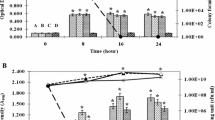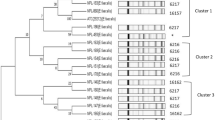Abstract
The aim of this study was to evaluate the probiotic characteristics and safety of seven Enterococcus faecalis isolates from fecal samples of healthy Chinese infants. We evaluated the isolates’ tolerance to low pH, survival in bile salts and NaCl, adhesion ability, biofilm formation, antimicrobial activity, toxin gene distribution, hemolysis, gelatinase activity, antibiotic resistance, and virulence to Galleria mellonella. All strains survived at pH 5.0, in 7.0% NaCl, and in 3% bile salt. Adhesion to Caco-2 cells was above 10%. Strain A3-1 had higher adhesion ability toward mucin, collagen, and BSA in vitro, better antibacterial activity, and the strongest biofilm production. We detected seven virulence genes with a distribution of asa1 (100%), cylA (71.4%), esp (85.7%), hyl (14.3%), gelE (85.7%), ace (42.9%), and agg (71.4%). Although all strains were γ-hemolytic, none showed gelatinase activity based on physiological activity detection. All isolates were susceptible to benzylpenicillin, ampicillin, ciprofloxacin, levofloxacin, moxifloxacin, tigecycline, nitrofurantoin, linezolid, and vancomycin; they were not susceptible to erythromycin, quinupristin/dalofopine, and clindamycin. The virulence test of G. mellonella showed that, except for strains 106-1 and 113-1, the other strains had toxicity lower than 10%. Strain A3-1 may have the greatest potential to be developed as a probiotic.




Similar content being viewed by others

References
Gomes BC, Esteves CT, Palazzo ICV, Darini AL, Felis GE, Sechi LA, Franco BD, de Martinis EC (2008) Prevalence and characterization of Enterococcus spp. isolated from Brazilian foods. Food Microbiol 25:668–675. https://doi.org/10.1016/j.fm.2008.03.008
Starke IC, Zentek J, Vahjen W (2015) Effects of the probiotic Enterococcus faecium NCIMB 10415 on selected lactic acid bacteria and enterobacteria in co-culture. Benef Microbes 6:345–352. https://doi.org/10.3920/BM2014.0052
Strompfová V, Lauková A, Ouwehand AC (2004) Selection of enterococci for potential canine probiotic additives. Vet Microbiol 100:107–114. https://doi.org/10.1016/j.vetmic.2004.02.002
Gu R, Yang Z, Li Z, Chen S, Luo Z (2008) Probiotic properties of lactic acid bacteria isolated from stool samples of longevous people in regions of Hotan, Xinjiang and Bama, Guangxi, China. Anaerobe 14:313–317. https://doi.org/10.1016/j.anaerobe.2008.06.001
Pieniz S, Andreazza R, Anghinoni T, Camargo F, Brandelli A (2014) Probiotic potential, antimicrobial and antioxidant activities of Enterococcus durans strain LAB18s. Food Control 37:251–256. https://doi.org/10.1016/j.foodcont.2013.09.055
Marciňáková M, Klingberg TD, Lauková A, Budde BB (2010) The effect of pH, bile and calcium on the adhesion ability of probiotic enterococci of animal origin to the porcine jejunal epithelial cell line IPEC-J2. Anaerobe 16:120–124. https://doi.org/10.1016/j.anaerobe.2009.05.001
Li B, Zhan M, Evivie SE et al (2018) Evaluating the safety of potential probiotic Enterococcus durans KLDS6.0930 using whole genome sequencing and oral toxicity study. Front Microbiol 9. https://doi.org/10.3389/fmicb.2018.01943
Nami Y, Abdullah N, Haghshenas B, Radiah D, Rosli R, Yari Khosroushahi A (2014) A newly isolated probiotic Enterococcus faecalis strain from vagina microbiota. J Appl Microbiol 117:498–508. https://doi.org/10.1111/jam.12531
Arokiyaraj S, Hairul Islam VI, Bharanidharan R, Raveendar S, Lee J, Kim DH, Oh YK, Kim EK, Kim KH (2014) Antibacterial, anti-inflammatory and probiotic potential of Enterococcus hirae isolated from the rumen of Bos primigenius. World J Microbiol Biotechnol 30:2111–2118. https://doi.org/10.1007/s11274-014-1625-0
Popović N, Djokić J, Brdarić E et al (2019) The influence of heat-killed Enterococcus faecium BGPAS1-3 on the tight junction protein expression and immune function in differentiated Caco-2 cells infected with Listeria monocytogenes ATCC 19111. Front Microbiol 10. https://doi.org/10.3389/fmicb.2019.00412
Torres-Henderson C, Summers S, Suchodolski J, Lappin MR (2017) Effect of Enterococcus Faecium strain SF68 on gastrointestinal signs and fecal microbiome in cats administered amoxicillin-clavulanate. Top Companion Anim Med 32:104–108. https://doi.org/10.1053/j.tcam.2017.11.002
Morelli L, Capurso L (2012) FAO/WHO guidelines on probiotics: 10 years later. J Clin Gastroenterol 46:S1–S2. https://doi.org/10.1097/MCG.0b013e318269fdd5
Rathnayake IU, Hargreaves M, Huygens F (2012) Antibiotic resistance and virulence traits in clinical and environmental Enterococcus faecalis and Enterococcus faecium isolates. Syst Appl Microbiol 35:326–333. https://doi.org/10.1016/j.syapm.2012.05.004
Kafil HS, Mobarez AM (2015) Assessment of biofilm formation by enterococci isolates from urinary tract infections with different virulence profiles. J King Saud Univ Sci 27:312–317. https://doi.org/10.1016/j.jksus.2014.12.007
Macovei L, Ghosh A, Thomas VC, Hancock LE, Mahmood S, Zurek L (2009) Enterococcus faecalis with the gelatinase phenotype regulated by the fsr operon and with biofilm-forming capacity are common in the agricultural environment. Environ Microbiol 11:1540–1547. https://doi.org/10.1111/j.1462-2920.2009.01881.x
Templer SP, Rohner P, Baumgartner A (2008) Relation of Enterococcus faecalis and Enterococcus faecium isolates from foods and clinical specimens. J Food Prot 71:2100–2104. https://doi.org/10.1089/cmb.2008.C002
Togay SO, Keskin AC, Acik L, Temiz A (2010) Virulence genes, antibiotic resistance and plasmid profiles of Enterococcus faecalis and Enterococcus faecium from naturally fermented Turkish foods. J Appl Microbiol 109:1084–1092. https://doi.org/10.1111/j.1365-2672.2010.04763.x
Marinho AR, Martins PD, Ditmer EM, d’Azevedo PA, Frazzon J, van der Sand S, Frazzon AP (2013) Biofilm formation on polystyrene under different temperatures by antibiotic resistant Enterococcus faecalis and Enterococcus faecium isolated from food. Braz J Microbiol 44:423–426. https://doi.org/10.1590/S1517-83822013005000045
Diego MP, Marta L, María A et al (2009) Adhesion properties of Lactobacillus casei strains to resected intestinal fragments and components of the extracellular matrix. Arch Microbiol 191:153–161. https://doi.org/10.1007/s00203-008-0436-9
Zhang F, Jiang M, Wan C, Chen X, Chen X, Tao X, Shah NP, Wei H (2016) Screening probiotic strains for safety: evaluation of virulence and antimicrobial susceptibility of enterococci from healthy Chinese infants. J Dairy Sci 99:4282–4290. https://doi.org/10.3168/jds.2015-10690
Bobenchik AM, Hindler JA, Giltner CL, Saeki S, Humphries RM (2014) Performance of Vitek 2 for antimicrobial susceptibility testing of Staphylococcus spp. and Enterococcus spp. J Clin Microbiol 52:392–397. https://doi.org/10.1128/JCM.02432-13
Maturana P, Martinez M, Noguera ME et al (2017) Lipid selectivity in novel antimicrobial peptides: implication on antimicrobial and hemolytic activity. Colloid Surface B 153:152–159. https://doi.org/10.1016/j.colsurfb.2017.02.003
Vidana R, Rashid MU, Özenci V, Weintraub A, Lund B (2016) The origin of endodontic Enterococcus faecalis explored by comparison of virulence factor pattern s and antibiotic resistance to that of isolates from stool samples, blood cultures and food. Int Endod J 49:343–351. https://doi.org/10.1111/iej.12464
Martino GP, Espariz M, Gallina Nizo G, Esteban L, Blancato VS, Magni C (2018) Safety assessment and functional properties of four enterococci strains isolated from regional Argentinean cheese. Int J Food Microbiol 277:1–9. https://doi.org/10.1016/j.ijfoodmicro.2018.04.012
Pieniz S, de Moura TM, Cassenego APV et al (2015) Evaluation of resistance genes and virulence factors in a food isolated Enterococcus durans with potential probiotic effect. Food Control 51:49–54. https://doi.org/10.1016/j.foodcont.2014.11.012
Jankowska A, Laubitz D, Antushevich H, Zabielski R, Grzesiuk E (2008) Competition of Lactobacillus paracasei with Salmonella enterica for adhesion to Caco-2 cells. J Biomed Biotechnol 2008:1–6. https://doi.org/10.1155/2008/357964
Barbosa J, Gibbs PA, Teixeira P (2010) Virulence factors among enterococci isolated from traditional fermented meat products produced in the North of Portugal. Food Control 21:651–656. https://doi.org/10.1016/j.foodcont.2009.10.002
Sauvage E, Kerff F, Fonzé E, Herman R, Schoot B, Marquette JP, Taburet Y, Prevost D, Dumas J, Leonard G, Stefanic P, Coyette J, Charlier P (2002) The 2.4-Å crystal structure of the penicillin-resistant penicillin-binding protein pbp5fm from Enterococcus faecium in complex with benzylpenicillin. Cell Mol Life Sci 59:1223–1232. https://doi.org/10.1007/s00018-002-8500-0
Elhadidy M, Elsayyad A (2013) Uncommitted role of enterococcal surface protein, Esp, and origin of isolates on biofilm production by Enterococcus faecalis isolated from bovine mastitis. J Microbiol Immunol Infect 46:80–84. https://doi.org/10.1016/j.jmii.2012.02.002
Sieńko A, Wieczorek P, Majewski P et al (2015) Comparison of antibiotic resistance and virulence between biofilm-producing and non-producing clinical isolates of Enterococcus faecium. Acta Biochim Pol 62:859–866. https://doi.org/10.18388/abp.2015_1147
Garg S, Mohan B, Taneja N (2017) Biofilm formation capability of enterococcal strains causing urinary tract infection vis-a-vis colonization and correlation with enterococcal surface protein gene. Indian J Med Microbiol 35:48–52. https://doi.org/10.4103/ijmm.IJMM_16_102
Franz CMAP, Huch M, Abriouel H, Holzapfel W, Gálvez A (2011) Enterococci as probiotics and their implications in food safety. Int J Food Microbiol 151:125–140. https://doi.org/10.1016/j.ijfoodmicro.2011.08.014
Vankerckhoven V, Van Autgaerden T, Vael C et al (2004) Development of a multiplex PCR for the detection of asa1, gelE, cylA, esp, and hyl genes in enterococci and survey for virulence determinants among european hospital isolates of Enterococcus faecium. J Clin Microbiol 42:4473–4479. https://doi.org/10.1128/JCM.42.10.4473-4479.2004
Mishra AK, Ghosh AR (2018) Characterization of functional, safety, and probiotic properties of Enterococcus faecalis AG5 isolated from Wistar rat, demonstrating adherence to HCT116 cells and gastrointestinal survivability. 10:435–445. https://doi.org/10.1007/s12602-018-9387-x
Peleg AY, Jara S, Monga D, Eliopoulos GM, Moellering RC, Mylonakis E (2009) Galleria mellonella as a model system to study Acinetobacter baumannii pathogenesis and therapeutics. Antimicrob Agents Chemother 53:2605–2609. https://doi.org/10.1128/AAC.01533-08
Tsai H, Liao C, Chen Y, Lu PL, Huang CH, Lu CT, Chuang YC, Tsao SM, Chen YS, Liu YC, Chen WY, Jang TN, Lin HC, Chen CM, Shi ZY, Pan SC, Yang JL, Kung HC, Liu CE, Cheng YJ, Liu JW, Sun W, Wang LS, Ko WC, Yu KW, Chiang PC, Lee MH, Lee CM, Hsu GJ, Hsueh PR (2012) Trends in susceptibility of vancomycin-resistant Enterococcus faecium to tigecycline, daptomycin, and linezolid and molecular epidemiology of the isolates: results from the tigecycline in vitro surveillance in Taiwan (TIST) study, 2006 to 2010. Antimicrob Agents Chemother 56:3402–3405. https://doi.org/10.1128/AAC.00533-12
Funding
This work was financially supported by the National Natural Science Foundation of China (81673199), the Fundamental Research Funds for the Central Universities of China (xjh012019054) and the Natural Science Foundation of Shaanxi province, China (2018JM7054).
Author information
Authors and Affiliations
Corresponding author
Ethics declarations
Conflict of Interest
The authors declare that they have no competing interests to this paper.
Additional information
Publisher’s Note
Springer Nature remains neutral with regard to jurisdictional claims in published maps and institutional affiliations.
Electronic supplementary material
ESM 1
(PDF 1541 kb)
Rights and permissions
About this article
Cite this article
Wang, J., Da, R., Tuo, X. et al. Probiotic and Safety Properties Screening of Enterococcus faecalis from Healthy Chinese Infants. Probiotics & Antimicro. Prot. 12, 1115–1125 (2020). https://doi.org/10.1007/s12602-019-09625-7
Published:
Issue Date:
DOI: https://doi.org/10.1007/s12602-019-09625-7



